How To Set Up Powerline Adapter
Instead of running new Ethernet cables to connect your devices to your dwelling house network then why non use your existing electric ability cables?
That is the idea behind Powerline or Homeplug networks.
Annotation: HomePlug is the family name for power line specifications for networking over existing home electric wiring.
HomePlug adapters are typically used to connect not Wi-Fi equipped devices to a home network, and to extend the range of existing networks.
Y'all normally buy homeplug adapters in pairs, and in this case all you need to do is plug them in, and they piece of work.
However replacing faulty devices or extending an existing powerline network is a unlike story.
What you will Learn
In this guide we will look at powerline networking using homeplug Ethernet adapters, how it works, and how you set up a home network. You will learn:
- How powerline networking works.
- How Information technology integrates into your existing home network.
- How to create a powerline network using homeplug adapters
- How to add and remove adapters from a network
- How various standards interoperate.
- What tools you can use.
Powerline Networking Overview
Powerline networking utilizes your existing mains electrical cable to connect devices together.
Devices similar computers plug into a powerline adapter using an Ethernet cable with a UTP connector, just like they would plug into an Ethernet hub or switch.
The electric line adapter and then plugs into the mains, and uses the mains wiring to transmit the data.
Another power line adapter is required somewhere on the same mains cable system to excerpt the signal.
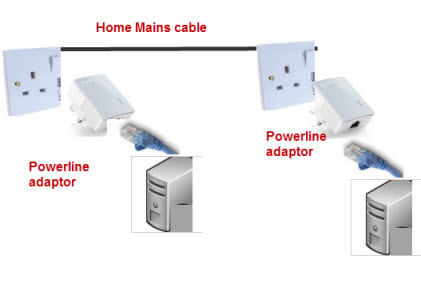
Advantages
- No additional wiring required
- Wiring is usually subconscious
- Can use Powerline adapter to power the device eastward.g. with pass through devices
- Fast speeds of 500Mbps are possible with new models
- Long range and not afflicted by thick walls and other obstacles like Wi-Fi.
Mutual Powerline Uses
They are oft used:
- To connect devices to a home network that are out of range of the wireless router.
- To connect a device to the network that requires a high speed and reliable connection east.g. games consoles.
- To provide wireless range extension using a powerline Wi-Fi booster.
Powerline/Homeplug Standards
Powerline standards have evolved since the initial homeplug 1.0. Information technology is important to be aware of the different standards because of potential inter operability problems.
The standards are:
- Homeplug 1.0 Speeds 14Mbs
- Homeplug 1.0 with Turbo Speeds 85Mbs
- Homeplug AV speeds 200Mbs speeds of 500Mbps are now bachelor and marketed normally as AV500.
- Homeplug AV2 (latest) Maximum speed currently 1200Mbps
- HomePlug Dark-green PHY -low ability version and depression speed.
Encounter Wiki- for more detail.
HomePlug Inter-Operability
You lot volition probably face up inter operability issues when you need to add some other adapter to an existing network or supervene upon a faulty adapter.
Generally homeplug ane.0 devices volition merely work with other homeplug 1.0 devices, and Homeplug AV,AV2 and HomePlug Green PHY volition all work together, but will not piece of work with Homeplug 1.0 devices.
- Homeplug 1.0 works with HomePlug 1.0 Turbo (85 Mbps).
- HomePlug AV tin can coexist on same cable with Homeplug 1.0 adapters, only volition not piece of work with homeplug ane.0.
- HomePlug AV 200 works with homeplug AV 500M simply at the lower speed.
- AV,AV2 and HomePlug Green PHY are fully interoperable but at the speed of the lowest speed adapter.
Annotation: Coexist means that they practise not interfere with each other when plugged into the same mains wiring organization
How Powerline Adapters Work
Having a basic understanding of how the powerline network works is crucial to troubleshooting problems, and for building,repairing and upgrading them.
Powerline adapters share the same physical media (the mains cable).
This means that in a neighbourhood of houses that all use powerline adapters there is a potential security run a risk.
To overcome this powerline adapters form logical networks based on a security key or password called a NMK (Network Management Key).
This central is used to encrypt the data on the network using 128 bit AES (AV2 standard) or 56 scrap DES (AV1 standard).
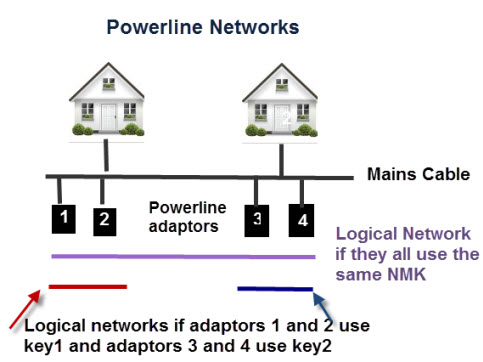
Creating Powerline Networks
To build a powerline network you need at least ii homeplug adapters.
Commonly you buy adapters in pairs, and the manufacturer will commonly ship each pair with a common NMK.
This means that when you plug them into your mains socket they volition institute a connection between themselves, and grade a logical network.
If they don't automatically establish a connection and then yous will need to intervene and manually initiate pairing.
The bones idea is that you lot put i of the adapters in a receptive fashion where it listens for another adapter trying to establish a connection.
You and then do the same with the other adapter. The two adapters should locate each other and agree a shared key.
Notation: the adapters will call up this key fifty-fifty if they are unplugged from the mains.
Note: On Older adapters (AV1) don't have a share/security button to initiate the paring process y'all may need to program each adapter with the aforementioned key using the software utility that comes with the adapter.
Some manufactures will transport adapters with a common NMK.
This means that adding adapters to an existing network is easy as the new adapters have the same NMK as the ones already on the network.
However this is a security gamble and you should modify the NMK from the default.
Powerline Networking Scenarios
- Creating a new powerline network.
- Replacing a broken adapter.
- Calculation new adapters to an existing powerline network.
- Leaving a Network.
Creating a New Powerline Network
This assumes that yous accept purchased the adapters equally a pair. In which instance merely plug them into the mains socket preferably close to each other and they should pair.
One time paired y'all can motility them to the required location.
If they don't pair then use the pairing procedure below, just you may also want to consult the documentation that came with the adapters.
Pairing Procedure
- Press the security or NMK button on adapter A for less than iii seconds and the ability LED should flash
- Within one minute Press the security or NMK button on adapter B for less than 3 seconds and the power LED should flash.
- Both power LEDs should stop flashing and stay illuminated for a successful connection.
If pairing is unsuccessful and then see troubleshooting section.
Replacing a Broken Adapter
If one of you adapters goes faulty then you can replace it. However you should be enlightened of the following.
- Homeplug one.0 works with HomePlug i.0 Turbo (85 Mbps) but not with Homeplug AV1 or AV2 adapters. Therefore if you have the older adaptors then consider replacing both adapters with new ones.
- If you Have Homeplug AV1 adapters and so effort to replace the broken ane with one of the same speed, and from the same manufacturer when possible. Notwithstanding it is non crucial as devices from different manufactures should work together.
- A Homeplug AV1 200Mbps adapter paired with a Homeplug AV1 500Mbps adapter will run at the lower speed.
To pair the new adapter to the existing one use the same pairing procedure as covered above, If pairing is unsuccessful and then see troubleshooting department.
Adding new Adapters to an Existing Powerline Network
Adapters must exist added one at a fourth dimension and the pairing process carried out each time.
For example to add together two new adapters C and D to an existing network with adapters A and B then proceed as follows:
- Pair adapter C with either Adapter A or B but not both.
- Pair adapter D with either Adapter A or B or C.
- The Logical network now consists of adapters A,B,C,D
Note: pairing procedure covered higher up:
Leaving a Network.
To remove an adapter from an existing network then press the security/NMK push button for 10 seconds while however plugged information technology.
The adapter will generate a new random password which places it exterior the existing logical network.
Troubleshooting
Things to try
- If they don't pair you lot can endeavour resetting both devices by pressing the security/NMK button for 10 seconds and then try again.
- You lot can also apply the the utility that came with your adapters to set the key on the adapters. Come across using the Powerline utility.
Extending Wi-Fi Coverage
Homeplug adapters can also come with built in wireless access points which allows you to hands and quickly provide Wi-Fi coverage in other locations
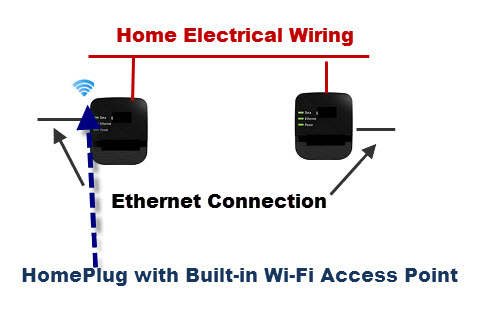
Using The Powerline Software Utility
You should receive a DVD with your adapter containing software that you can use to mange your powerline adapters.
If not you should be able to download the software online.
I use TP-link adaptrrs and in that location are two utilities available.
The tpPLC.exe utility shows a nice powerlink map whereas the powerline browse .exe utility is for configuring private adapters.
The tpPLC.exe utility lets y'all add devices,set device names,turn off leds,fix new security password all through a prissy GUI.
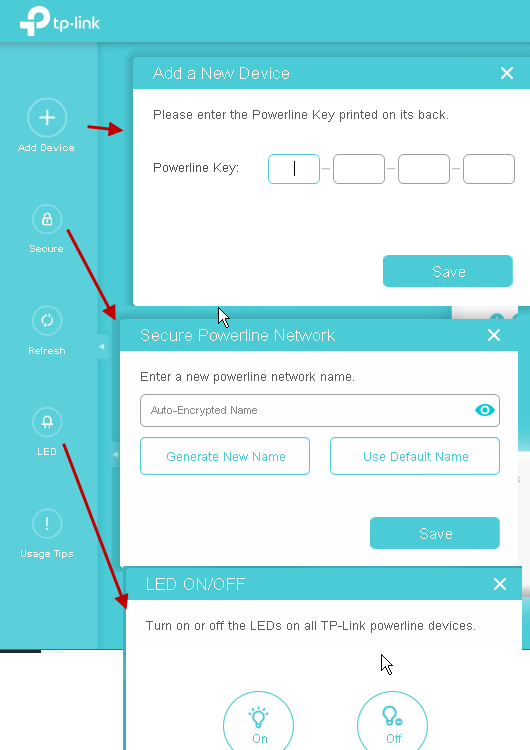
However the best feature is the network map which shows you all of the discovered adapters and the line speeds and an example is shown beneath.
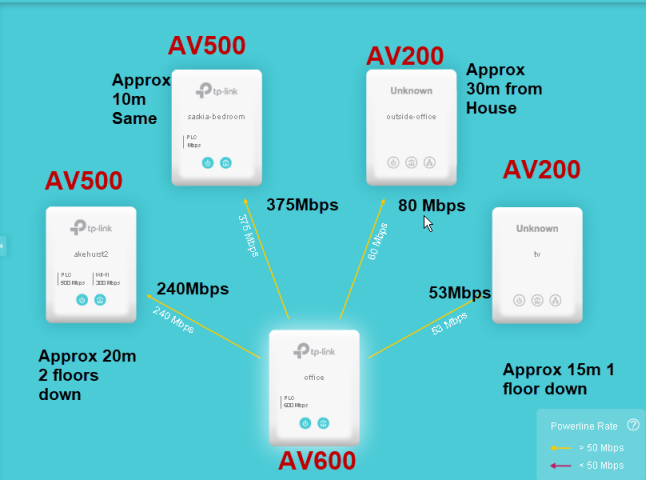
Powerline Speeds
Just like WiFi there are published speeds for each powerline standard. These speeds are theoretical maximum speeds and you will no get them in exercise.
The line speed you get is determined by the cabling in your home/office and the altitude betwixt adapters.
In addition considering all powerline adapters share the same medium (mains cable) the number of devices that are continued besides affects the throughput speed.
If you look at my diagram taken form my network you lot tin see that the maximum line speed is much less than the theoretical speed and that altitude also plays a role.
A good rule of thumb is to half the theoretical line speed so for a 600Mbps adapter look around 300Mbps.
In that location is an interesting table on this forum page showing alive test results for adapters nether unlike load conditions.
Even so generally the speed for even the low speed av200 adapters is much quicker than the Internet connectedness speeds (15-100Mbps).
Line Speeds and Throughput Speeds
The line speed is the actual fleck charge per unit on the line. Nonetheless because this line is shared by other devices the speed of each device (throughput) is less than the line speed.
So every bit a crude example if two device were sending on a 300Mbit/southward line then each device would have a throughput speed of 150Mbps.
Measuring Throughput Speeds
These are very difficult to mensurate as they piece of work by transferring data between 2 computers at either cease of the connection.
A mutual utility is LANSpeedTest by Totusoft which is a simple free and powerful tool for measuring Local Area Network (LAN) speeds.
Information technology is not actually for non technical users as it is non easy to setup.
A lot of people try to measure using an Internet speed checker just that measures your overall connection speed which is limited past the slowest link in the concatenation which is ordinarily the Cyberspace connection itself. See Understanding Home Networking Speeds
Buying Adapters Quick Note
When purchasing high speed adapters e.g AV 500 and above check the speed of the Ethernet port as many older adapters used 100Mbps Ethernet.
So even though the line speed was 300Mbps the actual speed out was express past the Ethernet port.
Newer devices normally use 1Gbps Ethernet but check.
Summary
Powerline/Homeplug networks are very skillful way of extending your home network without running cables, and for connecting devices that need a fast and reliable connection.
Speeds are unremarkably much ameliorate than Wi-Fi and much more reliable.
Abbreviations Used
PLC Power Line Communication
NMK Network Membership Key
AVLN – Logical network of AV adaptors
Useful Videos
TP link Setup Video – The procedure is used for all makes of adaptor
Related Tutorials
- Build a Dwelling house Network
- See How to Wire your Dwelling Network
- How to Setup and Configure your Home Router
- VLANs on Home Networks
Resources and references:
- solorwise manual
- Homeplug AV White newspaper
- Netgear support-adding an adapter
- TP Link- how to pair adapters
Please Allow me Know if you establish it Useful
Source: https://stevessmarthomeguide.com/powerline-networking/

0 Response to "How To Set Up Powerline Adapter"
Post a Comment